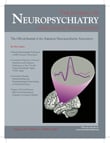Postpartum Catatonia Associated With Atypical Posterior Reversible Encephalopathy Syndrome
SIR: Postpartum psychosis is a psychotic illness that usually begins within 2 weeks of childbirth. It often manifests in manic symptoms and confusion, while catatonia is less frequent. 1 In contrast, posterior reversible encephalopathy syndrome (PRES) is a reversible encephalopathy characterized by various neurological and psychiatric symptoms. It generally involves the parieto-occipital lobes and is closely related to hypertension. Atypical manifestations of PRES in which other brain regions are disturbed have also been reported. 2 We report here a case of postpartum catatonia associated with atypical PRES.
Case Report
The patient was a 19-year-old Japanese woman without a history of psychiatric illness. She was treated in an obstetric hospital from the 36th week of pregnancy because of severe hypertension. She delivered a child by Caesarean section in the 37th week. Postoperatively, she gradually became confused. On Day 13 after childbirth, she fell into a catatonic stupor and was admitted to our hospital. On admission, her blood pressure was 160/110mmHg. Physical and neurological examinations, laboratory tests, lumbar puncture, and CT scan revealed no abnormalities. However, T2-weighted and fluid-attenuated inversion recovery (FLAIR) magnetic resonance (MR) images showed pontine hyperintensity. During the first week of admission, her blood pressure recovered to normal. Regimens of diazepam, 10mg/day, and haloperidol, 15mg/day, were administered intravenously, but her catatonic stupor remained unchanged. During the following month no changes were observed, despite discontinuation of the psychotropics. On the 43rd day of admission, midazolam, 5mg i.v., was administered prior to an MRI procedure. Shortly after the procedure, stupor suddenly disappeared, but she again fell into a stupor a few hours later. MRI on that day showed the disappearance of pontine hyperintensity. After that episode, enteral administration of etizolam, 3mg/day, and ethyl loflazepate, 4mg/day, was started. A month later, she was completely recovered.
Comment
In this case, the subacute appearance of catatonic stupor after childbirth was consistent with postpartum psychosis. This case was also diagnosed as atypical PRES, based on the reversible pontine hyperintensity and the absence of other organic brain disorders. In the treatment of catatonic syndrome, benzodiazepines and antipsychotics are the most reasonable options. 3 In the presence of the pontine lesion, the catatonic syndrome was resistant to these agents, while it responded remarkably to benzodiazepines after disappearance of the lesion. Elazar and Paz 4 previously noted a correlation between pontine dysfunction and catalepsy. In this case, atypical PRES could have played a critical role in the appearance and persistence of postpartum catatonia.
1. Brockington IF, Cernik KF, Schofield EM, et al: Puerperal psychosis: phenomena and diagnosis. Arch Gen Psychiatry 1981; 38:829–833Google Scholar
2. Ahn KJ, You WJ, Jeong SL, et al: Atypical manifestations of reversible posterior leukoencephalopathy syndrome. Neuroradiology 2004; 46:978–983Google Scholar
3. Delisle JD: Catatonia unexpectedly reversed by midazolam. Am J Psychiatry 1991; 148:809Google Scholar
4. Elazar Z, Paz M: Similarities between the akinesia induced by carbachol microinjections into the pontine reticular formation and neuroleptic catalepsy. Life Sci 1992; 51:1373–1380Google Scholar



